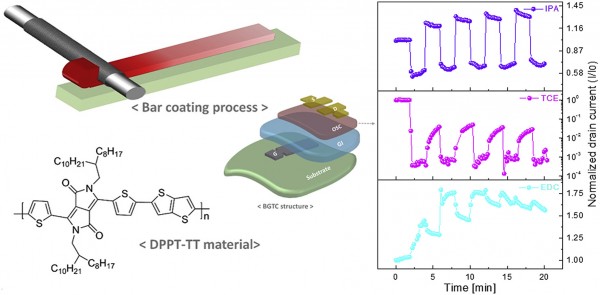Diketopyrrolopyrrole-based polymer transistors for hazardous volatile organic compound detection
- 저자
- Gi-Seong Ryu, Benjamin Nketia-Yawson, Eun-Young Choi*, Yong-Young Noh*
- 저널명
- Organic Electronics, 51, 264-268 (2017)
- 년도
- 2017
- Link
- https://doi.org/10.1016/j.orgel.2017.09.033 349회 연결
[Abstract]
Here, we report on highly sensitive OTFT sensors based on ultrathin poly[[2,5-bis(2-octyldodecyl)-2,3,5,6-tetrahydro-3,6-dioxopyrrolo[3,4-c]pyrrole-1,4-diyl]-alt-[[2,2′-(2,5-thiophene)bis-thieno(3,2-b)thiophene]-5,5′-diyl]] (DPPT-TT) organic thin film transistors (OTFTs) for detection of volatile organic compounds (VOCs). The flexible ultrathin DPPT-TT-OTFT sensors show high sensitivity of ∼87% in the exposed ammonia compared to ethanol and ethylene gases, which is ascribed to severe hole trapping in the semiconducting channel. Additionally, the gas sensor exhibit intense alteration of the OTFT performance parameters, including turn-on voltage, threshold voltage, and on and off current to common VOCs, such as 2-propanol, trichloroethylene, and 1,2-dichloroethane. In particular high sensitivity with good reversibility is achieved in the exposed 2-propanol.This work demonstrates that OTFTs with the dye-based conjugated polymers have great potential to realize real-time monitoring of various hazardous VOCs.
- 이전글Toward High Conductivity of Electrospun Indium Tin Oxide Nanofibers with Fiber Morphology Dependent Surface Coverage: Postannealing and Polymer Ratio Effects 24.12.15
- 다음글Selective sorting of semiconducting single-walled carbon nanotubes using thienylenevinylene-based conjugated polymers with high alkyl side-chain density 24.12.15
